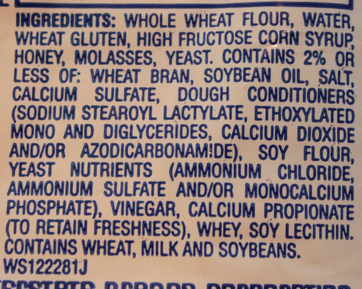 Since I don't eat processed foods, only homemade from scratch, I don't often have a need to look at the back cover of a particular product. However, this accidental bumping into the ingredient list of so-called natural, made me think how deceived we are as consumers. The ingredient list of the bread contained several processed and unhealthy ingredients that shouldn't ever be involved in the title "natural". Here are just few ingredients:
1. High fructose corn syrup. Where do I even start here? First of all, most high fructose corn syrup is made from genetically modified corn. Multiple studies have showed that consumption of HFCS is connected with a wide range of health problems. They include weight gain and obesity; hypertension and elevated “Bad” cholesterol levels. It’s especially destructive to your liver since everything we eat is processed by the liver. Recent studies have uncovered high levels of mercury in HFCS. This mercury intake can result in cerebral and nervous system damage – especially in babies and kids.
2. Soybean oil. First of all, the vast majority of soy products in America are not health foods. Compared to the Asian culture, where people eat small amounts of whole non-GMO soybean products, our western food processors separate the soybean into two products—protein and oil which can never be called natural or safe. Dr. Kaayla Daniel, author of The Whole Soy Story, points out thousands of studies linking soy to malnutrition, digestive distress, immune-system breakdown, thyroid dysfunction, cognitive decline, reproductive disorders and infertility—even cancer and heart disease.
3. Propionate. Calcium propionate is a preservative used to delay the growth of mold, rope bacteria and other microorganisms in a variety of commercially processed foods. Any additives or preservatives of any kind could be dangerous. Calcium propionate preservative has been associated with allergic reactions in bakers as well as sleep problems and restlessness in children.
4. Ammonium sulfate. It is an inorganic salt that occurs naturally near active volcanoes and is used commercially to nourish yeast and help bread rise. This compound is full of nitrogen, which is why it's commonly used as fertilizer. Some of the affects of consuming ammonium sulfate is irritation to the gastrointestinal tract which includes diarrhea and naseua.
These are just few ingredients used in our every day food. It's obviously not going to cause major problems if you consume these ingredients very rarely but overtime a constant intake of them and perpetual build up of toxins in our bodies will definitely have its effect on our health. If you still want your comfort food, take the time to make your own. At least you will be sure of all the ingredients you consume.
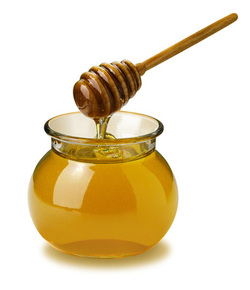 To look beautiful, feel good, be slim and healthy is not as hard as it might seem. Unlimited resources combined with exercise can lead us to desired results. A combination of honey and cinnamon have been discovered by researches as a great aid in weight loss. These components individually have beneficial effects on the metabolic processes and as a consequence - normalize weight. However, it turns out, that in tandem, they become a real elixir of youth and health. Honey and cinnamon are used to treat many diseases: heart disease, arthritis, inflammation of the bladder, indigestion and stomach disorders... even cancer. It can help in skin infections, alopecia, hearing loss, relieves dental pain and unpleasant smells from the mouth, as well as flatulence. Honey and cinnamon help to reduce cholesterol in the blood, accelerates healing of insect bites, helps fight against acne.
Honey and Cinnamon for weight loss
It is known that cinnamon helps to reduce the level of both sugar and cholesterol in the blood, as well as normalize the process of digestion and bowel cleansing. Honey, in its turn, is also famous for not only powerful immunostimulating properties, but also cleansing. There are many recipes for eliminating toxins from an organism with the use of honey. And in combination with cinnamon its anti-bacterial properties are even greater: the honey and cinnamon kill parasites (worms), which impede normal digestion, and in this way purify from toxic sediments. In addition, this combo prevents the accumulation of fat. However, make sure you use REAL RAW UNPASTEURIZED HONEY. If the label says Pure, honey can still be pasteurized, thus buy honey that says RAW or UNPASTEURIZED. In unpastarized honey live enzymes, natural compounds and phytonutrients, are intact. Manuka honey from New Zealand is the best honey around and is known for its many health benefits.
What's the Formula? According to the First International Symposium on Honey and Human Health and The Benefits of Honey, the mixture of honey and cinnamon fules the liver and helps burn fat. Mix together 1 tbsp. of cinnamon and 1 tbsp. of honey in a glass of warm water. Don't add honey when the water is hot as the heat will destroy all the nutrients in it. Drink this mixture in the morning on an empty stomach and in the evening before bed.
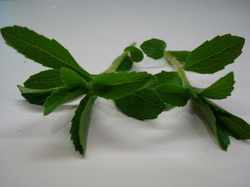 I am sure by now we are all familiar with Stevia, or at least have heard about it. Some of you might think that Stevia is just one of the many sugar substitutes similar to Splenda. However, this couldn't be further from the truth. Stevia is a 100% natural sweetener extracted from the leaf of the Stevia plant where other sweeteners are chemically produced. Stevia rebaudiana is a South American shrub. It grows in semi-arid areas of Brazil and Paraguay. Guarani people originally used the leaves of the plant for generations as a sweetener. They jealously kept these sweet plants as a secret to the rest of the world; thus, only in 1887, thanks to the South American naturalist Antonio Bertoni, Stevia has become known to the world. It turned out that in America there are almost 300 varieties of stevia, but only Stevia rebaudiana has a sweet taste. Its leaves are 10-15 times sweeter than regular sugar. The secret of its sweetness lies in the fact that the plant accumulates and contains a compound substance - stevioside. This substance is made of glucose, sucrose, steviol and other compounds. At the present time, stevioside is the sweetest natural product. In its pure form stevioside is 300 times sweeter than sugar. Until recently, the FDA has prohibited the sweetener from use in foods in the United States or Europe in order to promote the sales of aspartame, a artificial chemical sweetener, which has never been shown to be safe for human consumption. Fortunately, this was one of the rare instances when the best interest of the consumer has prevailed due to the efforts of people who have been warning about the dangers of aspartame. Most stevia is not sold in its raw, unprocessed form, but in powdered or liquid extract form. Stevia was found to contain different antioxidants including apigenin, kaempferol and quercitrin. Researchers have discovered stevia extracts' ability to protect DNA strands against damage by hydroxide radicals. Additionally, Webmd.com suggests that stevia could lower high blood pressure by using between 750-1500 mg of stevioside each day.
Also Stevia contains no calories and will not raise blood sugars. In fact, the research has showed that stevia is an insulin sensitizer that can aid in glucose tolerance and clearance after a meal. Stevia has been used by the Japanese for years in the treatment of type 2 diabeties. One of the most recent studies which was performed on fructose-fed rats, has showed that a single instance of oral stevioside increased insulin sensitivity and reduced postprandial blood glucose in a dose-dependent manner.
In conclusion, extract made from the leaves of the Stevia plant is undoubtedly the safest sweetener on the market. You can enjoy the natural sweetness without the guilt of the calories.
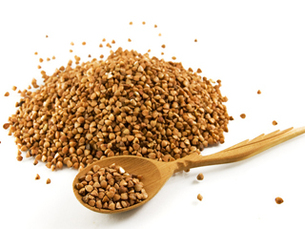 Buckwheat The idea of preparing meals with buckwheat is anything but new to me. I grew up eating buckwheat pretty much on a daily basis. Did I get tired of it? At times! But now I am really happy because I was accustomed to it from an early age. In the Soviet Union, if people didn't have much food there was always buckwheat. No matter where you went you didn't have to go far to find it. Not long after moving to California, I got home sick, and the first thing I wanted to have was buckwheat. A simple thing turned out to be a mission. I realized that it's not a common food in US. I ended up finding it at Whole Foods but it was definitely a cultural experience having to look hard for buckwheat. So what is so good about buckwheat?
Buckwheat originated in the mountainous areas of India and Nepal, where it's unique biochemical composition has benefited it's people for over 4000 years. In the 15th century (BC), due to the undemanding growing conditions of buckwheat, it's cultivation spread to Japan, China and Korea, and a little later - the countries of Central Asia, the Caucasus and the Middle East.
Today, Russia grows about half of the global harvest of buckwheat and for many years it has been the world's main consumer of this useful plant.
Despite its name, buckwheat has nothing to do with wheat. It is not a cereal grain at all. It’s the seed of the fagopyrum plant, which is in the same family as sorrel and rhubarb. It does not contain gluten. So referring to buckwheat as a seed than a grain would be more appropriate.
Buckwheat provides numerous nutritional benefits. It is a great source of vitamins B1 and B2. Rutin, which can be found in buckwheat, is actively prescribed for high blood pressure, rheumatism and other diseases. Rutin also has antioxidant activities and able to fight against free radicals in your body. Buckwheat is also rich in various minerals, such as magnesium, calcium, phosphorus, copper, zinc and bromine. Most of all, it is a great source of iron, so it is recommended for people suffering from anemia. Researchers have discovered that if you eat buckwheat with fruits, the absorption of iron in our bodies will increase. Buckwheat is full of dietary fiber which helps relieve constipation. Buckwheat is a good source of protein. The complete protein in buckwheat has 8 essential amino acids which are not produced by the body.
In short, Buckwheat should be a staple in all of our diets.... Please share any recipes you may have which include Buckwheat.
 How much water should you drink a day? We have all heard the idea of drinking at least eight cups of water per day but this notion is misleading. This suggestion first surfaced in the 1940s, and lately it's been widely supported by water companies. Glasgow doctor Margaret McCartney stated (in the medical journal BMJ) that this guideline is linked to Danone, which owns Evian, Volvic and Badoit.
"When you think about the way that the body handles water, you pee it out. The body regulates water very carefully and doesn't allow it to accumulate. Extra water is immediately excreted," says Dr. Stanley Goldfarb, a professor and an expert on fluid intake at University of Pennsylvania. Additionally, he says: "When you get thirsty, the deficit of water in your body is trivial -- it's a very sensitive gauge. It might be only a one percent reduction in your overall water. It just requires drinking some fluid."
Certainly water is a healing source, which normalizes the work of the gastro-intestinal tract and improves metabolism which burns fat. However, drinking much more than required by our body can put pressure on the kidneys. Researchers have proved, that excessive drinking of water can lead to a electrolytic imbalance in the human body and even lead to death.
The bottom line here - drink as much water as needed to quench your thirst. As being over-hydrated can lead to some health problems as well. In General, it's somewhat problematic to calculate the required amount of water for a person. There are many factors that determine our daily water requirements such as humidity and temperature of the environment, the quantity and composition of food, the work load, individual characteristics.... There is no established formula to determine the required amount of water for an individual.
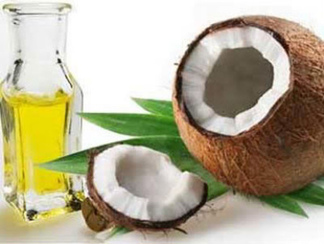 Why is there so much buzz about coconut oil, you might ask? Indeed, a plethora of research has been dedicated lately to this incredible super food. This research has proven many health benefits of coconut oil. Of course, its proponents do not claim it to be a panacea but incredible health benefits are undeniable. As you know, in order to absorb all of the healthy fat-soluble nutrients in your food, you must consume them with some fat. These choices include olive oil, butter, coconut oil, avocado, etc. However, not all oils give you the same benefits. When it comes to adding fat in your food, coconut oil is superior in nutrient absorption due to its medium chain fatty acids (MCFAs). Coconut oil is nature’s richest source of healthy MCFAs. Coconut oil is composed of approximately 66% medium-chain triglycerides. So why go with an oil like Coconut oil? Coconut oil helps you absorb more antioxidants and other nutrients from food. Compare to LCFAs, medium chain fatty acids do not require special enzymes to work properly by your body. Major benefits of medium chain fatty acids are:
- MCFAs are directed straight to your liver where they are converted into energy right away. Thus, they don't get stored as fat.
- They are digested easily by your body
- MCFAs in coconut oil help speed up your body’s metabolism, which leads to weight loss.
Additionally, coconut oil is rich in lauric acid which is also found in breast milk. Pure coconut oil consists of about 50 percent lauric acid, which makes it the most abundant natural source of lauric acid available. Your body converts lauric acid into monolaurin, a monoglyceride compound which possesses antiviral, antimicrobial, antiprotozoal and antifungal properties.
Since polyunsaturated fats (vegetable oils such as corn, soy, safflower, sunflower and canola) are the worst oils to use in cooking, coconut oil is the best alternative to these because it is nearly a complete saturated fat, which means it is much less susceptible to heat damage.
 Dangers of Milk We are all well familiar with the slogan "Got Milk?".... This marketing strategy has worked for years. The entire society (backed up by government suggestions) vigorously promotes the consumption of dairy. How else are we going to get the calcium and Vitamin D that is proudly featured on every carton of milk? Well, along with the promised calcium and added Vitamin D, you are a getting other things that might make you reconsider drinking milk, or at least scale back on it.
Potential Health Risks Associated with Milk
Casein Intolerance
Casein is the main protein in milk and dairy products. Casein acts in a similar way to gluten which can potentially lead to severe auto-immune problems. If you are gluten intolerant, you are most likely casein intolerant as well. Respiratory problems, allergies and illnesses are associated with the consumption of casein. Dr. T. Campbell wrote in his book “The China Study” about a very vivid correlation between animal protein consumption and cancer development, thus showing that casein protein promoted cancer in every stage of its development. The casein protein found in milk is called A1 beta casein which is a long chain of amino acids. It is believed to be the result of a genetic mutation in cattle. The protein found in ancient breeds of cattle is called beta-casein A2. During digestion A1 beta casein is broken down into a peptide flow of 7 amino acids called beta casomorphin (BCM7). Beta-casein A1 has a weak bond to BCM7. Thus, much of BCM7 gets into our bloodstream, which can easily pass through the blood brain barrier into the brain where it can bind to opioid receptors. These opioids have an effect on immune function which is linked to autoimmune disorders. The absorption of BCM7 activates many changes in the immune system, in the brain, and in the blood vessels.
Dairy Products are Acidifying
Cow’s milk and its products produce acid.The consumption of milk creates a net metabolic acidity in the body. In order to return to a body's natural alkaline state and neutralize the acidity, calcium and phosphorous are drawn from your bones. Many scientific studies have shown that not only do our bodies barely absorb the calcium in cow’s milk, but actually calcium loss is increased. Amy Lanou Ph.D., nutrition director for the Physicians Committee for Responsible Medicine in Washington, D.C., states, “The countries with the highest rates of osteoporosis are the ones where people drink the most milk and have the most calcium in their diets. The connection between calcium consumption and bone health is actually very weak, and the connection between dairy consumption and bone health is almost nonexistent.”
Elevated Insulin Levels
Milk is very insulinogenic. Even though the glycemic index of dairy products is relatively low, it has a high insulin index. Researchers have found that both proteins in milk, casein and whey, stimulate the production of insulin from the pancreas. In 2001 the study of 3,000 infants with genetically increased risk for developing diabetes was done in Finland. It demonstrated that early introduction of cow’s milk increased susceptibility to type 1 diabetes.
There are other alternatives to drinking milk which include raw fermented choices such as whole milk yogurt, kefir, cultured butter, clotted milk. The general process of milk fermentation involves the production of lactic acid from lactose in the milk. Fermentation increases the shelf-life of the product, and improves the digestibility of milk.From lahealthyliving.com
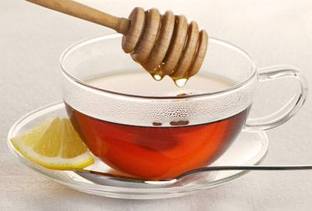 Natural Prevention Of Colds If we were to point out the most annoying thing about winter and cold days, we would probably put getting sick on top of the list. We try to do anything possible to stay healthy and avoid catching a cold. I think the only time I wished I were sick when I was a teenager wanting to ditch school; that was when the turmoil of being sick sounded like a sweet escape. Not any more! I pride myself of staying healthy and as a norm getting sick once a year. However, I still want to avoid that. So what are some natural ways of cold prevention? I emphasize natural because I can honestly say I don't rely on typical medication, nor can I remember buying it last. - Cod liver oil. Of all the superfoods out there, I would definitely put this on top of the list. People don't realize how good cod liver oil is for them. It’s incredibly full of fat-soluble vitamins that support the immune system and fatty acids like EPA and DHA that reduce inflammation. EPA is the precursor of important prostaglandins (localized tissue hormones that help the body deal with inflammation). Cod liver oil has more vitamin A and more vitamin D per unit weight than any other food. A single teaspoon of high-vitamin oil contains nearly 2000 IU. There are virtually no infectious diseases that do not respond well to treatment which consists of cod liver oil.
- Thyme has amazing antiviral, bactericidal, fungicidal, antibiotic, and antiseptic properties which makes it a great natural additive during cold and flu season. Not only is thyme is known for killing microbes, but it also helps the body to eliminate toxins. In addition, it benefits the immune system by encouraging the formation of white blood cells, increasing immune response to invading organisms.
- Add turmeric to your meals or to ginger tea. Turmeric's anti-bacterial agents may help our body fight against colds, cough and flu. Turmeric's key ingredient Curcumin is known for its anti-bacterial and anti-inflammatory properties which can help in healing cuts and wounds.
- Honey and Cinnamon. Taking one tablespoon of lukewarm honey with 1/4 teaspoon cinnamon powder daily for 3 days will help prevent and cure most chronic cough, cold and clear the sinuses. Consistent use of honey helps fight bacteria and viral diseases by strengthening the white blood corpuscles.
- Coconut Oil. Coconut oil is a modern day panacea. It possesses many health benefits that can boost your immune system due to lauric acid which is converted into monolaurin in your body. This compound possesses antiviral and antimicrobial properties, thus destroying viruses and bacteria by dissolving the lipid coating around some viruses.
If sick, take 5-6 tablespoons per day in food.
 Flue Vaccine Dangers Every year we get bombarded with posters and slogans to get flue vaccines. We are witnessing a powerful psychological attack under the title "the Vaccine is the best protection against the flu!". You can't help but come to a conclusion that a common flue is the most dangerous thing in the world and thus, there is nothing else left for you to do except to get this shot. But wait! You have to know that flu vaccines have been proved to be not only ineffective but also toxic for humans and animals. According to the Centers for Disease Control and Prevention, "The following substances are found in flu vaccines: aluminum, antibiotics, egg protein, formaldehyde, human aborted fetal apparatus (dead human tissue), monosodium glutamate (MSG), and thimerosol (mercury)." Flu vaccines are directly linked to long-term health consequences.
Here are some of the conditions associated with flue vaccines:
- Facial edema.
- Immune system disorders
- Cardiovascular disorders
- Digestive disorders
- Diarrhea
- Nausea
- Vomiting
- Abdominal pain
- Blood and lymphatic disorders
- Local lymphadenopathy
- Transient thrombocytopenia
- Metabolic and nutritional disorders
- Loss of appetite
- Nervous system disorders
- Headache
- Dizziness
- Neuralgia
- Paraesthesia
- Febrile convulsions
- Guillain-Barré Syndrome
- Neuropathy (including neuritis)
- Paralysis (including Bell’s Palsy)
- Respiratory disorders
- Chest pain
- Cough
- Urticaria
- Rash (including non-specific, maculopapular, and vesiculobulbous)
The invention of flu vaccines was associated with the notion that humans are unable to adapt to their environment on their own, thus, they ought to rely on modern technology to get through the seasons.
One of the many problems connected with flue vaccines is the fact that it is virtually impossible to predict what strain of the virus will cause the epidemic in a given year. The flu virus is unpredictable since it changes its characteristics fast. Thus, last year's flu vaccine may be completely ineffective against a flu strain this year. This predicament makes pharmaceutical companies work hard to produce sufficient pathogen material by establishing the best conditions in which different virus strains develop.
The World Health Organization (WHO) sends the three most common strains to vaccine manufacturers so that they are part of the vaccine for the new season. “The trick is to get viruses, which can reproduce in these cells, but which have not changed so much that they are no longer good for the vaccination,” says Rolf Hömke from Germany's Association of Research-Based Pharmaceutical Companies (VFA). "The vaccines would not produce the desired immunity in the body", he adds. "When you get the flu vaccine, your body produces antibodies to three specific strains of the virus". This demonstrates that basically you have a 3 out of 300 chance of being vaccinated for the proper viral strain. Furthermore, by the time you get exposed, the viruses might adapt and change their form.
Additionally, if your body doesn't produce enough reaction or responds with a damaging one due to weak immune coordination, the vaccine will be useless as well. The choice is yours, you can keep getting those shots and hope for a great outcome, or you can start by taking care of your body in order to strengthen your immune system.
 Salmon Farm When you thought it couldn't get any worse, it kind of did! With all the ballot measures to label genetically modified foods and the tremendous concerns from the public, the food industry and FDA are still following the path of health destruction. Just recently the FDA gave the green light for the production of genetically engineered salmon as food. USA Today reports that "The Food and Drug Administration on Friday released an environmental assessment of the AquaAdvantage salmon, a faster-growing fish which has been subject to a contentious, years long debate at the agency. The document concludes that the fish “will not have any significant impacts on the quality of the human environment of the United States". The FDA will take comments from the public on its report for 60 days before making it final.
If FDA approves the production of the GM salmon, it would be the first scientifically altered animal approved for food anywhere in the world. Critics have already started calling the modified salmon a "frankenfish." We often opt for the food that is less in price but somewhat of the same quality. If you shop at conventional stores, most likely you will have a choice between wild caught fish and farm raised. Some time ago, I wouldn't even think twice but go for the lesser one in price. Sure enough, farm raised beat the wild one in its affordability. Consequently, salmon farms make up about 80% of salmon in America. However, it is worth spending more money on Wild Salmon because of all the health benefits it provides. It is truly a superfood if found in non-polluted waters. Alaskan salmon is considered the best type of salmon due to the remote Alaskan waters where they live. In comparison, farm salmon which are housed in net cages located in the ocean close off shore, are associated with some health risks because of the antibiotics and other chemicals used to treat farmed fish:
Farmed fish consist of more fat and less Omega-3 fatty acids due to the smaller area in which they swim, and the constant availability of food.
According to one of the studies, Farm-raised salmon contains significantly higher concentrations of PCBs, dioxin and other cancer-causing contaminants than salmon caught in the wild. Farmed fish contain higher concentrations of contaminants than wild fish largely because they are fed meal that consists of ground-up fish tainted with contaminants.
The rich pink color of wild caught salmon comes from red algae, shellfish, certain insects, and all the natural food of the ocean that they consume. Since farmed salmon are fed genetically modified grains and dead animal parts, their flesh is naturally grey. So, they are given artificial colorings to make them more appealing. The chemicals used to make it pink are canthaxanthin and astaxanthin.
So next time you are offered Salmon, make sure it is wild caught. Additionally, canned salmon would be a great affordable choice as well since farm raised salmon does not can well. Thus, they have to use a wild one. If you do choose to eat farmed salmon, the Environmental Working Group suggests eating no more than one serving of farmed salmon a month.
|










